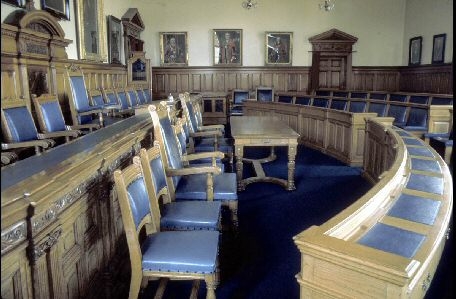A virtual tour of the Town Hall is now available.
It can be seen at the following YouTube Link : Virtual Tour of the Town Hall
—————————————————–
Morley Town Hall is a Grade 1 listed building, which celebrated its centenary in 1995. This window in the Town Hall says much about the town and its inhabitants. Their belief in social and industrial progress is evident, as was the way that they went about their business, the aims which they had, and their real achievements.

Following the granting of Borough status in 1885, the new Borough Council had really ambitious plans and they certainly wanted an impressive building for the Town Hall where the business of running a borough could be conducted, and where visitors could be entertained in surroundings of which the town could be proud.
The first Mayor of Morley, Joseph Schofield, and his fellow councillors decided that a design would be obtained by a competition and 73 entries were submitted. This was the winning design offered by Holtom & Fox, a firm of Dewsbury architects. They received £100 and, of course, they supervised some of the building.

By 1891, work had commenced and the granite foundation stone was laid on the 8th October 1892. The borough made it a big event and the Mayor, Alderman Thomas Clough, carried out the ceremony using a silver trowel. Many dignitaries from surrounding towns were also present. Flattened under the stone are various local newspapers of the day and histories of Morley written by Norrisson Scatcherd and William Smith.

The opening on 16 October 1895 was a grand event. At that time, Morley’s most famous son was the lawyer turned politician Herbert Henry Asquith who had been born in the town in 1852, so it seemed very appropriate that he be asked to do the opening.

At last, Morley had a building of some stature, literally and figuratively. It had cost over £41,000 to build and the dome is 160 feet high. It had a magnificent hall, the Great Hall, which later became the Alexandra Hall, in which meetings could be held and folks could enjoy various forms of entertainment. Originally there was seating for 1200 people but this has now been reduced to around 800.

The Great Staircase to the Mayor’s parlour and the council chamber must have impressed many visiting dignitaries. In addition the Town Hall had a magistrate’s court and the local police force were housed inside the building so that issues of law and order could be dealt with more effectively than was previously the case.
In the following years improvements were made to the building. This stained glass window was contributed by Charles Scarth, who was Mayor of the borough a record six times and certainly one of the most successful textile manufacturers in the area. Appropriately the window is dedicated, in Latin, to Industry. Another 12 windows were donated by other local personalities in 1902, all dedicated to different human activities and feelings. It is difficult to believe now that they only cost £25 each when they were made.

The council chamber was redesigned in 1937 to accommodate the extra Councillors from East and West Ardsley, Gildersome and Drighlington when these districts were incorporated into the borough.

The building became a focal point of the Borough and was the centre of any celebration, local or national. During the Second World War, the Town Hall was used for raising funds for the War effort, and between 1942 and 1945 such efforts raised over £1.5 million.
 The Town Hall got recognition of a less welcome kind on the 16th August 1961, when a fire broke out in the nearby Albert Mills and sparks reached the Town Hall. Despite the best efforts of the Fire Brigade it was not possible to save the dome which was completely destroyed. Happily, the rest of the building was undamaged, and the dome was restored, but the event was described in some detail on national television. The photograph shows firemen fighting the blaze on Back Wellington Street with the blazing Albert Mills in the background.
The Town Hall got recognition of a less welcome kind on the 16th August 1961, when a fire broke out in the nearby Albert Mills and sparks reached the Town Hall. Despite the best efforts of the Fire Brigade it was not possible to save the dome which was completely destroyed. Happily, the rest of the building was undamaged, and the dome was restored, but the event was described in some detail on national television. The photograph shows firemen fighting the blaze on Back Wellington Street with the blazing Albert Mills in the background.
These photographs from various local collections show that the Town Hall is still an important meeting place for Morleians and that it has been maintained in style. Meetings and discussions can be held in the Mayor’s Parlour in impressive and dignified surroundings, the Alexandra Hall remains an important centre for meetings and popular entertainment, such as brass band concerts, and the council chamber is again in use by the present Town Council for discussion of matters of public policy which affect the lives of local people.




You must be logged in to post a comment.